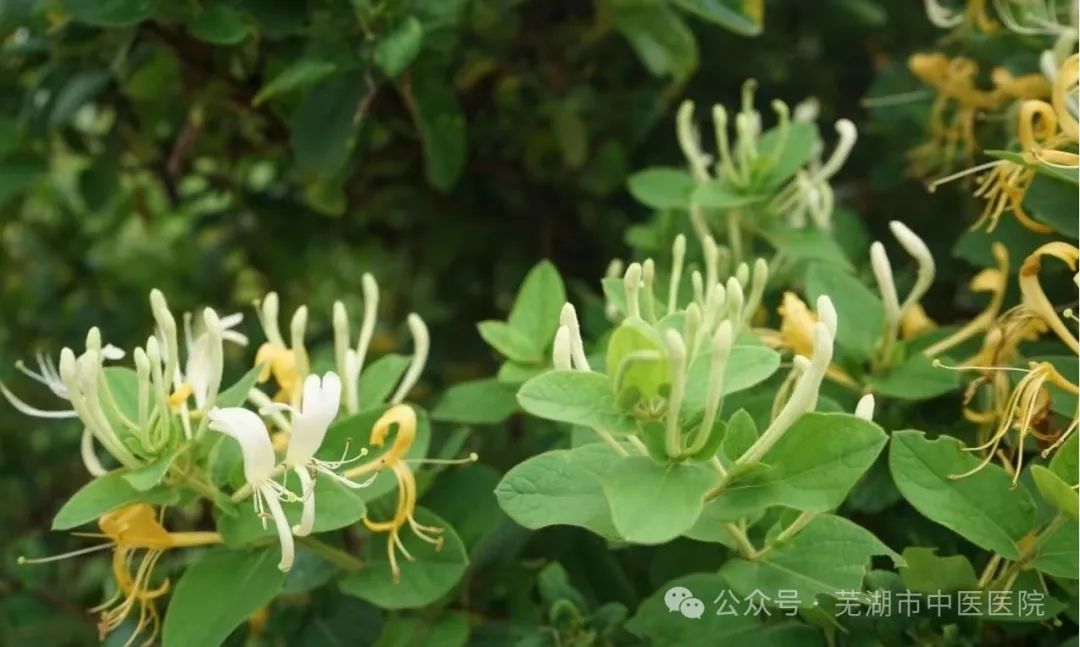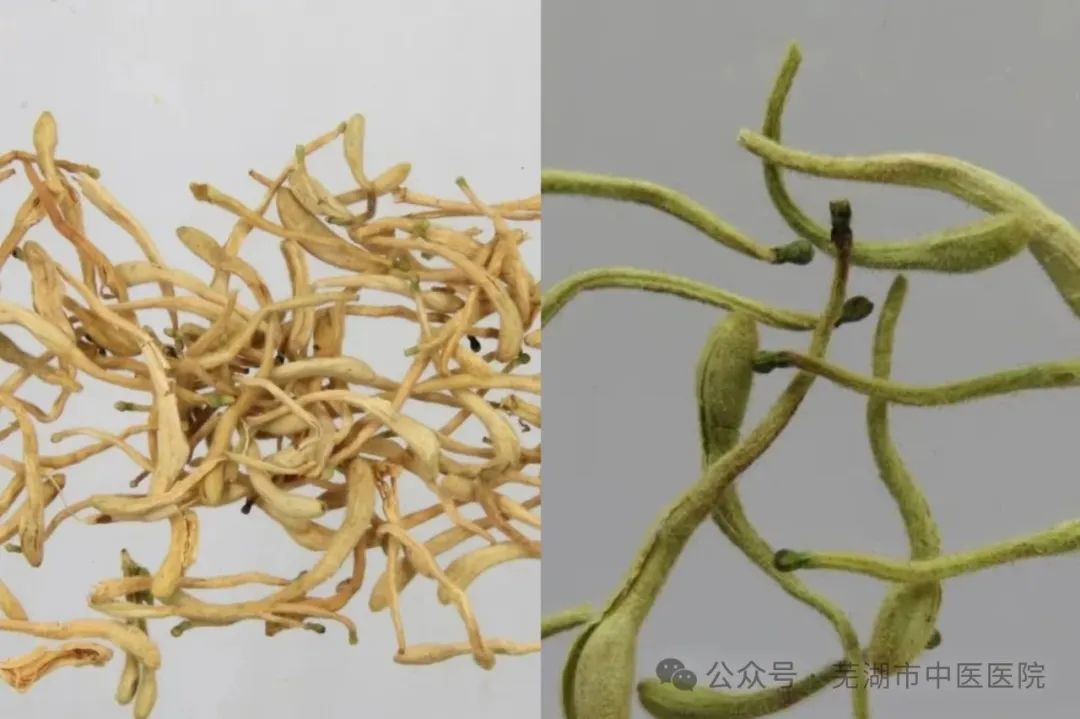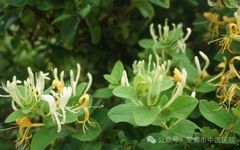Jin Yin Hua (Honeysuckle) is the dried flower buds or early blooming flowers of the plant Lonicera japonica Thunb, belonging to the Caprifoliaceae family. It is harvested in early summer before the flowers bloom and then dried. Jin Yin Hua is sweet and cold in nature; it enters the Lung (Fei), Heart (Xin), and Stomach (Wei) meridians. It has the effects of clearing heat and detoxifying, as well as dispersing wind-heat. It is used for conditions such as carbuncles, sore throat, erysipelas, heat-toxicity causing blood dysentery, wind-heat colds, and febrile diseases. Jin Yin Hua has been widely recognized for its medicinal value since ancient times. Modern research has proven that Jin Yin Hua contains pharmacologically active components such as chlorogenic acid and luteolin glycosides, which have strong inhibitory effects on various pathogenic bacteria, including hemolytic streptococci and Staphylococcus aureus, as well as viruses causing upper respiratory infections. Additionally, it can enhance immunity and can be combined with other medications to treat respiratory infections, bacterial dysentery, and acute urinary tract infections, thus earning the reputation of being a traditional Chinese medicine antibiotic.

1. Characteristics of Jin Yin Hua
This product is rod-shaped, thicker at the top and thinner at the bottom, slightly curved, measuring 2-3 cm in length, with an upper diameter of about 3 mm and a lower diameter of about 1.5 mm. The surface is yellowish-white or greenish-white (darkening with prolonged storage), densely covered with short soft hairs. Leaf-like bracts are occasionally seen. The calyx is green, with five lobes at the tip, and the lobes are hairy, about 2 mm long. The open flower has a tubular corolla, with a bilabiate tip; there are five stamens attached to the wall of the tube, yellow in color; and one pistil with a hairless ovary. It has a clear fragrance, with a mild, slightly bitter taste.

2. Chemical Composition of Jin Yin Hua
There are many reports on the chemical composition of Jin Yin Hua and related plants. A variety of chemical components have been isolated and identified from Jin Yin Hua, mainly including volatile oils, organic acids, flavonoids, triterpenoid saponins, and iridoids. Chlorogenic acid and luteolin are among its effective components.
3. Pharmacological Effects of Jin Yin Hua
Jin Yin Hua exhibits pharmacological activity in anti-inflammation, detoxification, antimicrobial action, immune regulation, liver protection, lipid-lowering, hemostasis, and enhancing immunity. Clinically, it is widely used for various infections, inflammations, high fever, hyperlipidemia, and dry mouth due to tumor radiotherapy and chemotherapy.
4. Clinical Applications of Jin Yin Hua
(1) Used for exterior wind-heat or the initial stage of warm diseases
Jin Yin Hua is sweet and cold, clearing heat from the Qi level and blood level, and has a slight dispersing effect, making it suitable for treating exterior wind-heat or the initial stage of warm diseases with unresolved exterior symptoms and excess internal heat. It is often combined with Lian Qiao (Forsythia), Niu Bang Zi (Burdock fruit), and Bo He (Mint) for use.
(2) Used for sores, carbuncles, and throat pain
Jin Yin Hua has a strong heat-clearing and detoxifying effect, making it a common choice in surgery. It is generally used for sores and carbuncles that are red, swollen, and painful, particularly suitable for conditions classified as “Yang syndromes”. It can be combined with Pu Gong Ying (Dandelion), Di Ding Cao (Hedyotis), Lian Qiao, Dan Pi (Moutan Cortex), and Chi Shao (Red Peony) for decoction, or fresh ones can be mashed and applied externally.
(3) Used for heat-toxicity causing dysentery with blood (stools mixed with mucus and blood)
Heat-toxicity accumulates in the intestines and enters the blood level, leading to dysentery with blood. Jin Yin Hua can cool the blood and resolve heat-toxicity, thus treating blood dysentery. Clinically, it is often used with Jin Yin Hua fried to charcoal, combined with Huang Qin (Scutellaria), Huang Lian (Coptis), Bai Shao (White Peony), and Ma Chi Xian (Portulaca) for use.
5. Precautions for Using Jin Yin Hua
(1) Jin Yin Hua can be soaked in water for oral use or combined with other herbs in decoctions, with a general dosage of 6-15 g. For external use, an appropriate amount is applied.
(2) Individuals with a history of allergy to Jin Yin Hua should avoid its use.
(3) Jin Yin Hua is cold in nature, suitable for individuals with a balanced constitution or internal heat; those with spleen and stomach deficiency or qi deficiency with pus that is thin and clear, belonging to Yin syndromes, should avoid it.
(4) Patients with favism should avoid Jin Yin Hua, as it may induce hemolytic reactions or worsen their condition.
(5) Do not consume overnight soaked Jin Yin Hua; cold drinks may lead to diarrhea. It should be consumed hot after being brewed with boiling water.
With the development of modern clinical research, the medicinal efficacy of Jin Yin Hua has been scientifically validated. In clinical practice, it is not uncommon to find that many antiviral traditional Chinese medicines contain Jin Yin Hua, such as the commonly used Lian Hua Qing Wen capsules (granules), Shuang Huang Lian oral liquid, Qing Kai Ling oral liquid, Kang Gan granules, and Ling Yang Gan Mao tablets. Traditional Chinese medicine has certain advantages in treating viral colds, as it not only has antiviral properties but also possesses antipyretic and anti-inflammatory effects, providing multiple actions against infections caused by viruses, such as shortening the duration of fever, controlling the spread of inflammation, and promoting the absorption of inflammation. Furthermore, some medications can enhance the body’s immune function and prevent viruses from entering cellular tissues. Due to the diversification of effective components in traditional Chinese medicine, viruses find it difficult to develop resistance, giving traditional Chinese medicine a significant advantage in treating viral infectious diseases, with broad clinical application prospects. As an antibiotic in traditional Chinese medicine, Jin Yin Hua is particularly widely used during flu seasons, highlighting its medicinal value.
However, it is important to remind everyone that while Jin Yin Hua is beneficial, it should not be misused. It is essential to use it under the guidance of traditional Chinese medicine diagnosis and treatment to maximize its medicinal value and achieve effective results.
Some images are sourced from the internet.
 Always follow the Party
Always follow the Party
Text by: Jiang Huilian
Edited by: Bao Shangzhen
Reviewed by: Wang Ping, Zhu Heping, Qi Ya
Grade Three Class A Traditional Chinese Medicine Hospital
Wuhu City Traditional Chinese Medicine Hospital
Consultation Phone
0553—3838500
(Service Time 8:00—17:30)


